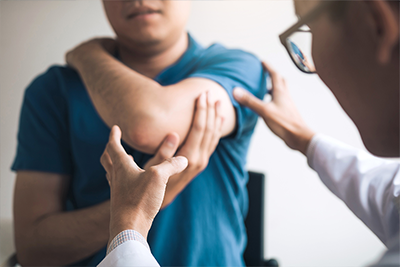Back pain is a common yet complex issue affecting millions worldwide. Whether it’s a fleeting ache or a chronic condition, understanding its causes, symptoms, and treatment options is crucial for effective management. At Vale Health Clinic, we specialise in helping individuals regain their comfort and mobility, offering solutions tailored to your specific needs.
Back Pain
Back pain can manifest in various ways, ranging from mild discomfort to debilitating pain that interferes with daily life. It’s one of the leading causes of missed workdays and reduced quality of life. While acute back pain often resolves within weeks, chronic pain—lasting three months or longer—requires more targeted treatment.
Main Causes of Back Pain
- Muscle or Ligament Strain: Overexertion, improper lifting techniques, or sudden movements can cause strains.
- Herniated Discs: The cushioning discs between vertebrae can rupture, pressing on nerves and causing severe pain.
- Postural Issues: Prolonged sitting, slouching, or standing improperly can stress the spine.
- Injuries and Accidents: Falls, car accidents, or sports injuries can result in fractures or dislocations.
- Degenerative Conditions: Osteoarthritis and disc degeneration are common in ageing adults.
- Nerve Compression: Sciatica, often caused by a herniated disc, can radiate pain from the back to the legs.
When Should You Get Medical Help?
While back pain often resolves on its own, specific symptoms signal a need for immediate attention:
- Persistent pain lasting more than a few weeks.
- Numbness, tingling, or weakness in the legs.,/li>
- Loss of bladder or bowel control.
- Pain following an accident or trauma.
- Severe, worsening pain that disrupts daily activities.
Treatment Options at Vale Health Clinic
-
Cortisone Injections
Cortisone injections are a targeted treatment to reduce inflammation and alleviate pain, especially for conditions like herniated discs or arthritis. Administered directly into the affected area, these injections provide fast, long-lasting relief and allow patients to engage in physical therapy or daily activities more comfortably.
-
Arthrosamid Injections
For chronic back pain, Arthrosamid is an innovative treatment designed to cushion the joints and reduce friction. This hydrogel injection provides durable pain relief, improves mobility, and is an excellent option for individuals who haven’t responded to other therapies.
-
Chiropractic Care
Our chiropractors use spinal manipulation, soft tissue therapies, and personalised exercise plans to alleviate pain and improve spinal alignment. Chiropractic care is especially effective for non-specific lower back pain.
-
Physical Therapy
Tailored exercise programmes focus on strengthening the core, improving flexibility, and promoting proper posture to prevent recurring pain.
FAQs about Back Pain
Q: What is the Most Common Cause of Back Pain?
The most common cause of back pain is muscle or ligament strain. This often results from lifting heavy objects improperly, sudden awkward movements, or overuse during physical activities. Poor posture and prolonged sitting can also contribute to muscle strain and discomfort.
Q: How Long Does Back Pain Last?
The duration of back pain can vary. Acute back pain, usually due to strains or sprains, typically lasts a few days to a few weeks and often resolves with rest and self-care. Chronic back pain persists for three months or longer and may require more extensive treatment.
Q: When Should I See a Doctor for Back Pain?
You should see a doctor if your back pain persists over a few weeks, worsens over time, or is accompanied by symptoms such as numbness, tingling, weakness, or loss of bladder or bowel control. Seek immediate medical attention if you experience severe pain following an injury or trauma.
Q: Can Bad Posture Cause Back Pain?
Yes, bad posture can cause back pain. Slumping, hunching over, or maintaining improper posture for extended periods places additional stress on the spine and surrounding muscles, leading to discomfort and pain.
Q: Is Exercise Good for Back Pain?
Exercise can benefit back pain, particularly activities that strengthen the core muscles and improve flexibility. Gentle exercises like walking, swimming, and yoga can help alleviate pain and prevent future episodes. However, it is important to avoid high-impact activities or exercises that exacerbate the pain.
Q: Can Stress Cause Back Pain?
Stress can contribute to back pain by causing muscle tension and spasms. Chronic stress can lead to prolonged muscle tightness, which can strain the back and lead to discomfort. Stress management techniques such as deep breathing, meditation, and regular physical activity can help reduce stress-related back pain.
Q: What Are Some Effective Home Remedies for Back Pain?
Effective home remedies for back pain include rest, applying ice or heat to the affected area, over-the-counter pain relievers like NSAIDs, and gentle stretching exercises. Maintaining good posture and avoiding activities that aggravate the pain can also help.
Q: What Are the Risks of Ignoring Back Pain?
Ignoring back pain can lead to worsening symptoms and potentially more severe conditions. Chronic back pain can affect your quality of life, leading to decreased mobility, sleep disturbances, and emotional distress. Early diagnosis and treatment are essential to prevent complications and improve outcomes.
Q: How Can I Prevent Back Pain While Working at a Desk?
To prevent back pain while working at a desk, maintain good posture, use an ergonomic chair with lumbar support, keep your feet flat on the floor, and position your computer monitor at eye level. Take regular breaks to stand, stretch, and walk around to reduce strain on your back.
Q: Is Chiropractic Care Safe for Back Pain?
Chiropractic care is safe for treating back pain when performed by a trained chiropractor. Spinal manipulation and other chiropractic treatments can relieve many types of back pain.
Preventing Back Pain
- Improve Posture: Keep your spine straight and shoulders relaxed when sitting or standing.
- Stay Active: Engage in low-impact activities like walking, swimming, or yoga.
- Ergonomics Matter: Use a supportive chair and position your desk to avoid slouching.
- Healthy Lifestyle: Maintain a balanced diet and a healthy weight, and avoid smoking, which can impair spinal health.
Vale Health Clinic
At Vale Health Clinic, we believe managing back pain goes beyond temporary relief. Our comprehensive approach focuses on identifying the root cause and providing tailored treatments to ensure long-lasting results. From guided injections like Cortisone and Arthrosamid to holistic therapies, we are committed to helping you live a pain-free life.
Take the First Step Towards Relief
Don’t let back pain hold you back. Contact Vale Health Clinic today for expert care and effective treatment options tailored to your needs. Whether it’s a minor ache or a chronic condition, we’re here to help you move freely and live comfortably.
Related Articles
- Lunge Stretch for Back Pain
- Will Exercise and Moving About Make Your Chronic Back Problem Worse?
- Back Exercises for Trapped Nerve
- Managing your Back Pain
- How to Manage Back Pain During Pregnancy!




























